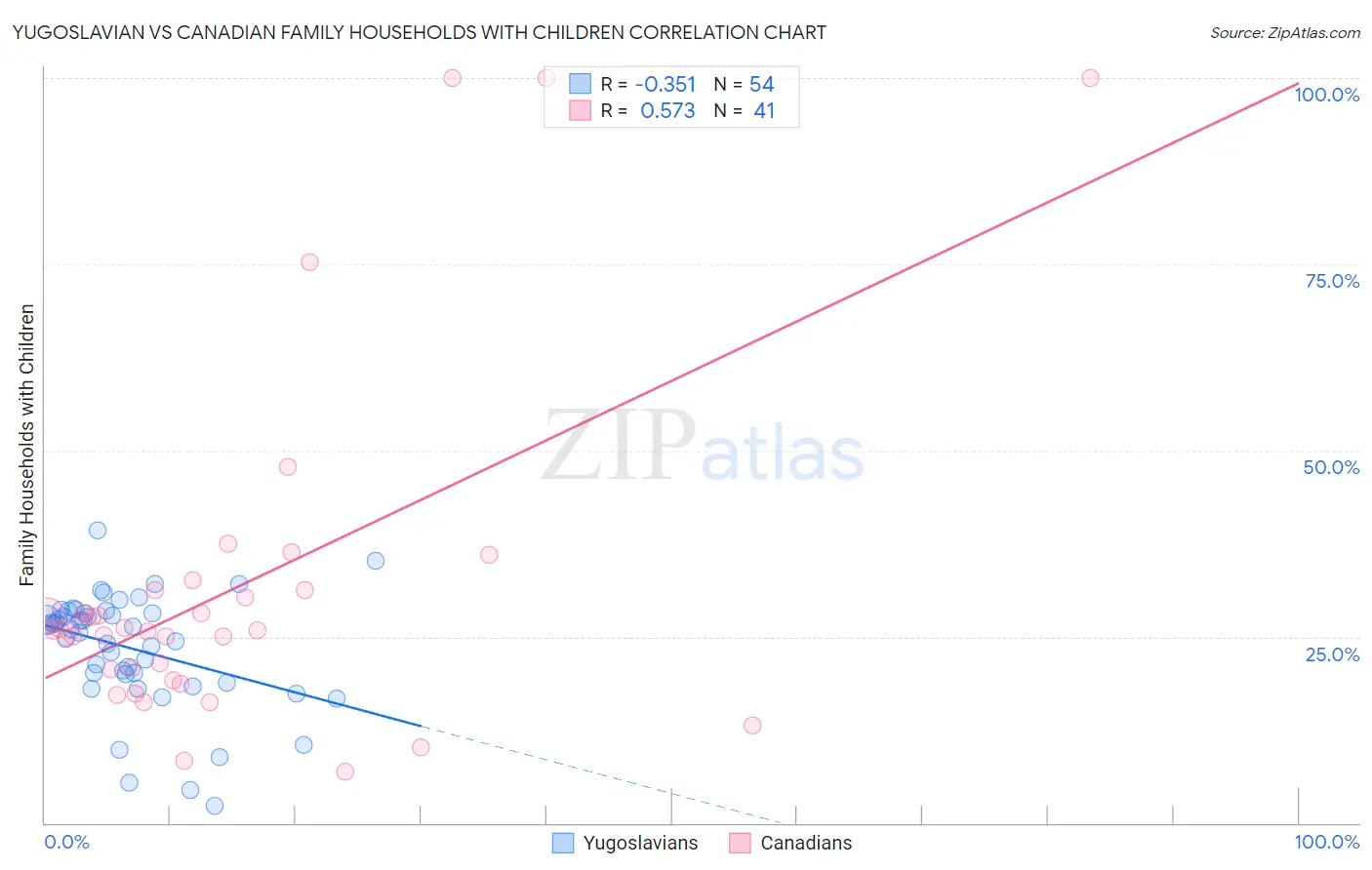Yugoslavian vs Canadian Family Households with Children
COMPARE
Yugoslavian
Canadian
Family Households with Children
Family Households with Children Comparison
Yugoslavians
Canadians
27.0%
FAMILY HOUSEHOLDS WITH CHILDREN
5.1/ 100
METRIC RATING
232nd/ 347
METRIC RANK
27.1%
FAMILY HOUSEHOLDS WITH CHILDREN
7.5/ 100
METRIC RATING
225th/ 347
METRIC RANK
Yugoslavian vs Canadian Family Households with Children Correlation Chart
The statistical analysis conducted on geographies consisting of 285,532,788 people shows a mild negative correlation between the proportion of Yugoslavians and percentage of family households with children in the United States with a correlation coefficient (R) of -0.351 and weighted average of 27.0%. Similarly, the statistical analysis conducted on geographies consisting of 437,085,688 people shows a substantial positive correlation between the proportion of Canadians and percentage of family households with children in the United States with a correlation coefficient (R) of 0.573 and weighted average of 27.1%, a difference of 0.24%.

Family Households with Children Correlation Summary
| Measurement | Yugoslavian | Canadian |
| Minimum | 2.3% | 6.9% |
| Maximum | 39.4% | 100.0% |
| Range | 37.1% | 93.1% |
| Mean | 23.5% | 31.4% |
| Median | 26.1% | 26.0% |
| Interquartile 25% (IQ1) | 19.9% | 19.9% |
| Interquartile 75% (IQ3) | 28.1% | 31.3% |
| Interquartile Range (IQR) | 8.2% | 11.4% |
| Standard Deviation (Sample) | 7.6% | 22.5% |
| Standard Deviation (Population) | 7.6% | 22.2% |
Demographics Similar to Yugoslavians and Canadians by Family Households with Children
In terms of family households with children, the demographic groups most similar to Yugoslavians are Immigrants from Italy (27.0%, a difference of 0.0%), Luxembourger (27.0%, a difference of 0.050%), Bulgarian (27.0%, a difference of 0.070%), Immigrants from Germany (27.0%, a difference of 0.080%), and Immigrants from Morocco (27.0%, a difference of 0.12%). Similarly, the demographic groups most similar to Canadians are Czechoslovakian (27.0%, a difference of 0.080%), Tsimshian (27.0%, a difference of 0.080%), Scottish (27.0%, a difference of 0.080%), German (27.1%, a difference of 0.090%), and Immigrants from Caribbean (27.0%, a difference of 0.11%).
| Demographics | Rating | Rank | Family Households with Children |
| Greeks | 11.4 /100 | #218 | Poor 27.1% |
| Immigrants | Japan | 10.7 /100 | #219 | Poor 27.1% |
| Austrians | 9.9 /100 | #220 | Tragic 27.1% |
| New Zealanders | 9.6 /100 | #221 | Tragic 27.1% |
| Paraguayans | 9.4 /100 | #222 | Tragic 27.1% |
| Pima | 9.2 /100 | #223 | Tragic 27.1% |
| Germans | 8.7 /100 | #224 | Tragic 27.1% |
| Canadians | 7.5 /100 | #225 | Tragic 27.1% |
| Czechoslovakians | 6.6 /100 | #226 | Tragic 27.0% |
| Tsimshian | 6.6 /100 | #227 | Tragic 27.0% |
| Scottish | 6.5 /100 | #228 | Tragic 27.0% |
| Immigrants | Caribbean | 6.3 /100 | #229 | Tragic 27.0% |
| Bulgarians | 5.8 /100 | #230 | Tragic 27.0% |
| Luxembourgers | 5.5 /100 | #231 | Tragic 27.0% |
| Yugoslavians | 5.1 /100 | #232 | Tragic 27.0% |
| Immigrants | Italy | 5.0 /100 | #233 | Tragic 27.0% |
| Immigrants | Germany | 4.4 /100 | #234 | Tragic 27.0% |
| Immigrants | Morocco | 4.2 /100 | #235 | Tragic 27.0% |
| Cape Verdeans | 3.6 /100 | #236 | Tragic 26.9% |
| Immigrants | Netherlands | 3.5 /100 | #237 | Tragic 26.9% |
| Moroccans | 3.4 /100 | #238 | Tragic 26.9% |